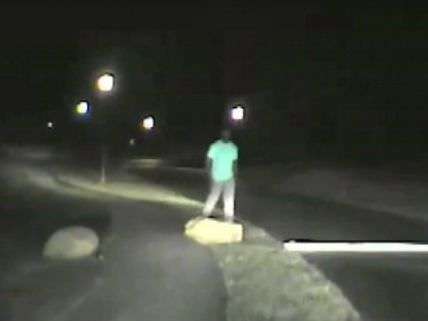Video Shows Seconds Before Cop Shot Jonathan Ferrell 10 Times
Ferrell is initially calm, then runs when light from a laser sight hits his chest.

Last week jurors in the manslaughter trial of North Carolina police officer Randall Kerrick were shown the dashcam video that convinced Kerrick's boss, Charlotte-Mecklenburg Police Chief Rodney Monroe, to arrest him the day Kerrick shot and killed Jonathan Ferrell. Early in the morning on September 14, 2013, Ferrell crashed his car and went looking for help at a nearby house, where he was mistaken for a burglar. The 34-second video, which was not publicly released prior to the trial, shows what happened after Kerrick and two other officers arrived at the scene in response to the report of a home intruder.
Ferrell initially walks calmly toward the officers, until the light from a stun gun's laser sight appears on his chest. Then he takes off, running between two patrol cars. Ferrell is now off camera, but Kerrick can be heard repeatedly ordering him to the ground. Within three seconds of the first command, Kerrick fires four rounds, then another eight. From the moment that Ferrell starts running until Kerrick completely empties his weapon, 11 seconds elapse.
Prosecutors argue that Ferrell ran between the police cars because he was alarmed by the laser lights on his chest, which as far as he knew came from a firearm loaded with bullets instead of a stun gun loaded with barbed, electricity-delivering darts. They say he fell to the ground after Kerrick fired four rounds at him but that Kerrick, who also had fallen to the ground after stumbling in a ditch while walking backward, fired eight more rounds because Ferrell kept moving. Ten of the rounds struck Ferrell.
Shortly after the shooting, in a videotaped interview that the jury saw on Friday, Kerrick said he fired when Ferrell failed to obey his commands and got within 10 feet or so of him. "It did not faze him," he said. "He kept coming toward me. I fired again." Kerrick said he ended up on the ground but he wasn't sure how, and Ferrell began climbing up his legs. "There was nothing I could do to get him off of me," he said. "Then I fired again." By contrast, in his opening statement last week, Kerrick's lawyer said Ferrell had tackled him and punched him in the face while trying to grab his gun.
Kerrick did not mention being tackled or punched in the face during the interview, but an EMT testified that he mentioned a punch in face at the scene and had an injury consistent with that. Kerrick's lawyer said Ferrell's DNA was found on the slide and trigger of Kerrick's gun, which is consistent with an attempt to grab the weapon. But if Ferrell ducked between the cars out of fear, running toward Kerrick only by accident, three seconds is an awfully short time for him to process Kerrick's command, recognize him as a police officer who intended him no harm (maybe), and get down on the ground. Once he had been shot, an attempt to grab the gun of a man who seemed intent on killing him would be perfectly understandable and consistent with the physical evidence described by the defense.
Kerrick will get a chance to flesh out his self-defense claim as the trial continues this week, and perhaps he will present eyewitnesses who can back up his account. But we already know that the two other officers at the scene did not perceive Ferrell as a big enough threat to draw their own guns, and Ferrell's demeanor when he first sees the cops hardly suggests an aggressive intent.


Show Comments (61)